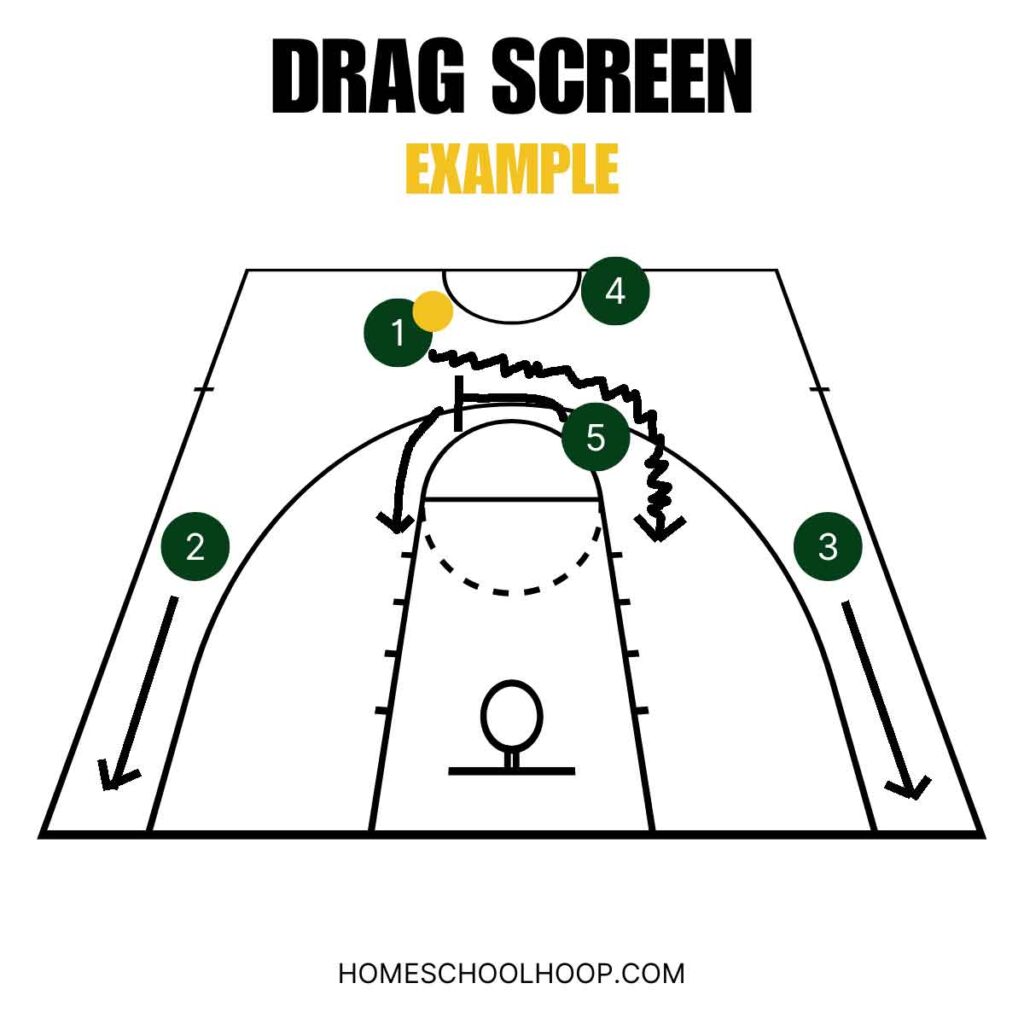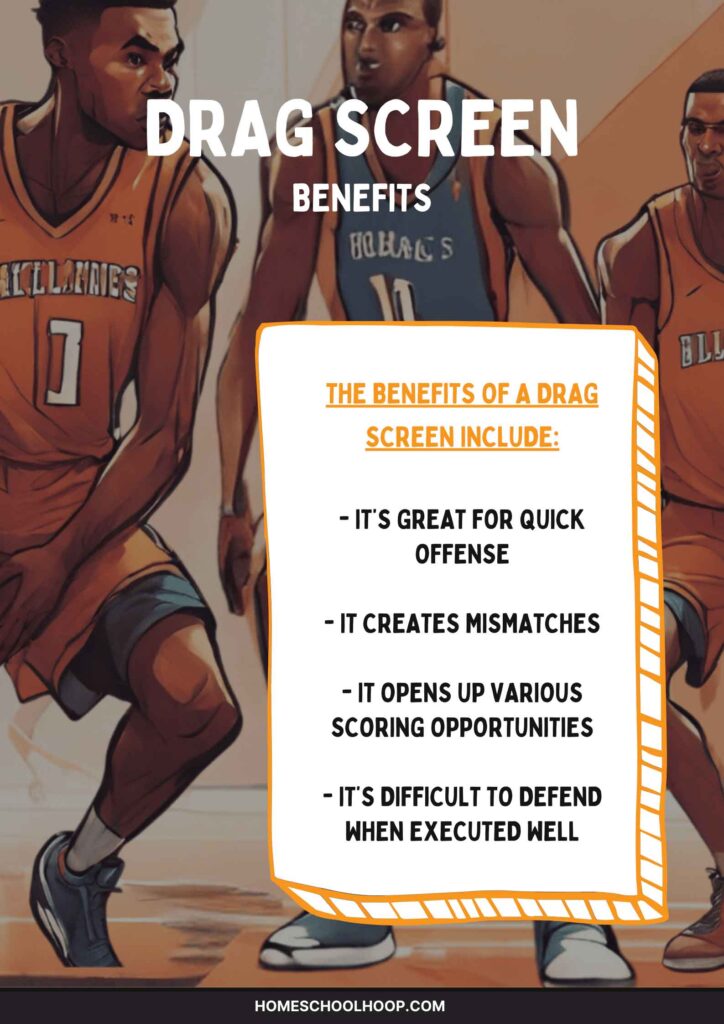Basketball today moves at lightning speed, with teams pushing the pace to exploit defensive weaknesses for easy points. Within these quick transitions or fast breaks, the drag screen emerges as a strategy. Setting a screen for the ball handler after the initial transition break throws off the defense’s attempt to regroup and defend.
Key Takeaways:
- A drag screen in basketball is a ball screen set during a fast-break or transition play.
- This tactic confuses the defense while they’re still trying to organize, leading to mismatches against defenders and chances to score.
- A quality drag screen relies on the right timing, positioning, and communication between the screener and the ball handler.
In this article, we’ll simplify the drag screen, explaining what it is, the perfect moments to use it, and offering practical advice on doing it right. We’ll also cover the typical mistakes to avoid so you can pull it off successfully.
What is a Drag Screen?
A basketball drag screen is a type of ball screen set right after the initial transition break, usually between an explosive ball-handler and a trailing center or another larger post player.

Unlike set plays that occur in a stationary offensive formation, a drag screen is characterized by its timing (during transition) and its location (shortly after crossing half-court, often near the top of the key). It’s designed to catch the defense off-guard during a team’s transition from defense to offense.
It offers flexibility and spontaneity and works best with a playmaking ball-handler who reads the defense well.
How It’s Executed:
- Transition: After the team has gotten a defensive rebound and moves from defense to offense, the center or post player, usually trailing, prepares to set the screen.
- Setting the Screen: The screen is set for the ball handler, typically at the top of the key, to create scoring opportunities by driving to the basket or finding an open teammate.
- Quick Decisions: The ball handler must read the defense to decide whether to attack the basket, pass to the screener rolling toward the basket, or find another open teammate.
The Benefits of Using a Drag Screen
The main goal of the drag screen is to apply pressure on the defense early in the possession, making it difficult for them to organize and defend effectively.
The benefits of a drag screen include:
- It’s great for quick offense.
- It creates mismatches and confusion among the defense who are still getting situated.
- It opens up various scoring options.
- It’s simple to implement yet difficult for defense to counter when executed well.
Quick Offense
A drag screen can help a team score quickly during their possession. This can be helpful during end-of-game situations when a team is fighting back from a deficit and needs to get some quick baskets. Teams may also use it throughout a game to try and spark some offensive rhythm.
Creates Mismatches
Because drag screens usually involve a center screening for a guard, they can create mismatches if the defense decides to switch assignments on the screen.
If the center’s defender steps out to take the guard with the ball, they usually lack the speed to stick with them. And even if they do, the guard’s defender is now tasked with defending a center who dominates them in size and strength.
Learn more: Who are the tallest WNBA players? Or, Who is the tallest NBA player?
Opens Up Various Scoring Options
For the ball-handler, a drag screen creates separation from their defender. This can lead to multiple scoring opportunities. No matter how the defense plays it, the ball-handler has a counter option.
- If their defender gets slowed down or caught up in the screen, they can drive directly to the rim or pull up for an open jumper.
- If the ball-handler breaks free from their defender but is picked up by another defender who has left their player to help, they can pass to an open teammate for a shot opportunity.
- If the defense fights through the screen successfully, the ball-handler can pass to the screener in pick and roll action.
Simple to Run, Difficult to Guard
Drag screens put a lot of pressure on the defense when they’re confused and preoccupied with finding the player they’re defending. During this transition from offense to defense, they’re less likely to be in a position where they can adequately defend a ball screen.
For example, the center’s defender may focus on sprinting back to protect the rim and be out of position for hedging the drag screen.
Drag screens can also take advantage of lazier defenders who don’t communicate.

Setting Up a Successful Drag Screen
A successful drag screen takes more than knowing what it is. Its effectiveness hinges on the right positioning and timing by both the screener and the ball handler.
- Timing is Key: The screener must set the screen at the exact moment the ball handler is ready to use it. Too early or too late can render the screen ineffective. Or worse, it could lead to an illegal screen foul.
- Optimal Positioning: The screen should be set near the top of the key as the team transitions from defense to offense, at an angle that creates an open lane for the ball-handler to drive downhill toward the rim.
Regular drills that mimic game situations can help players get comfortable with the timing, positioning, and communication required for successful drag screens. Also, watching and analyzing successful and unsuccessful drag screens can provide valuable insights into what works and what doesn’t.
Tips for the Screener
- Angle of the Screen: Set yourself square to the defender so they have to go around you, giving your teammate the space they need. The angle should force the defender to choose between going over the screen or getting caught on it.
- Solid and Legal Positioning: Stand firm with feet shoulder-width apart at least one stride away from the defender.
- Avoid Fouls: Don’t lean and keep your arms and legs inside rather than extend them to avoid a moving screen call.
- Roll Hard: After setting the drag screen, roll hard toward the rim. This encourages other defenders to come off their players to help, opening up kick-out threes.
Tips for the Ball Handler
- Communicate: Use non-verbal cues and communicate with the screener so you’re both on the same page that you’re executing a ball screen.
- Use the Screen: Wait for your screener to be fully set before making your move.
- Make the Read: Watch the defense’s reaction to the screen. Decide whether to drive, shoot, or pass based on their movement and the space created.
Common Mistakes and How to Avoid Them
Even high-performing strategies like the drag screen can prove ineffective if not executed properly. Here, we identify common mistakes teams make while attempting drag screens and offer guidance on how to avoid these pitfalls.
#1 Mistake: Poor Timing
- The Issue: Setting the screen too early or too late makes it ineffective by not giving the ball handler enough space or by leading to a moving screen foul.
- The Fix: Work on timing, either through drills or in scrimmage situations, to synchronize the screener’s movement with the ball handler’s actions. The screen should be set just as the ball handler is ready to use it.
#2 Mistake: Incorrect Positioning
- The Issue: If the screener sets the screen in the wrong spot or at the wrong angle, it won’t open up space or create scoring opportunities.
- The Fix: Practice setting screens in various game-like scenarios to understand the optimal positions and angles.
#3 Mistake: Lack of Communication
- The Issue: Without proper communication, the ball handler might not know a screen is being set. This can lead to missed opportunities or turnovers.
- The Fix: Develop clear, concise signals between the screener and the ball handler. Whether verbal or non-verbal, these cues should indicate when the screen will be set.
#4 Mistake: Moving While Screening
- The Issue: Because it’s such a dynamic play, a common foul called during drag screens is for moving while setting the basketball screen. This results in a turnover and reduces scoring chances.
- The Fix: The screener must set a solid, stationary screen. And the ball-handler needs to wait for the screener to get set before taking off.
#5 Mistake: Failing to Read the Defense
- The Issue: The ball handler not adjusting their decision based on the defense’s reaction to the screen. This can lead to forced plays or turnovers.
- The Fix: Ball handlers should practice reading different defensive setups and reacting accordingly. This includes deciding when to drive, shoot, or pass based on the space and matchups created by the screen.
FAQs About Drag Screens
What is a drag screen in basketball?
A drag screen in basketball is a type of ball screen executed during transition. A screener (usually a center or forward) sets a screen for ball-handler (usually a guard) just after crossing half-court. This catches the defense off guard and opens quick scoring opportunities
What is a double drag screen?
A double drag screen involves two screeners setting screens for a ball handler shortly after half-court, during secondary transition. The two screens are set in succession. This increases the chances of disrupting the defense and creating scoring opportunities early in a possession.
LET US KNOW
Today, you learned about the drag screen in basketball.
So we want to know: Do you have any tips or tricks for a drag screen effectively that we missed?
Let us know in the comments.

